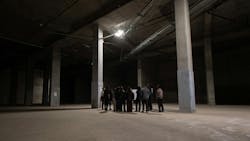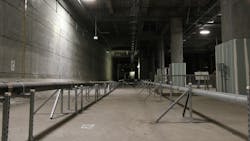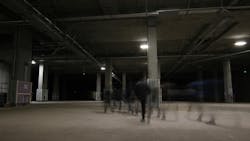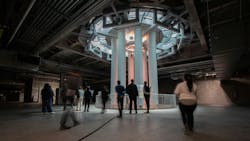Inside the four-block-long train station quietly taking shape beneath downtown San Francisco
Accessing the site requires descending multiple flights of stairs, squeezing into a freight elevator and navigating a maze of narrow hallways before entering the vast space known as The Portal. Formally called the Downtown Rail Extension, the project is overseen by the Transbay Joint Powers Authority (TJPA) and will bring a massive underground station stretching four blocks beneath San Francisco’s South of Market neighborhood. Since it was first proposed in the 1990s, The Portal has faced decades of delays due to increasingly high-cost estimates and shifting political priorities, but with recent advancements, the project appears closer than ever to connecting Caltrain and eventually high-speed rail directly into the city’s core.
Upon entering the dim, seemingly endless space, Lily Madjus Wu, communications and legislative affairs director at the TJPA, drew attention to the towering concrete panels lining the back side of the station. These panels, she explained, are nicknamed knockout walls. As construction resumes, the walls will be knocked down to make way for the tunnels feeding into the station. Although the only thing currently past these walls is dirt, plans are in place for the construction of a tunnel that will emerge at Caltrain’s current terminus at 4th and King, about 1.3 miles from downtown.
When that station opened in 1975, it was intended to serve only as a temporary endpoint until the downtown extension to The Portal could be completed. Extending Caltrain to downtown via The Portal is expected to slash daily commuter travel times by nearly an hour while linking seamlessly to 11 Bay Area transit systems.
Beyond addressing Caltrain’s inconvenient terminus, The Portal is also planned to serve as the California high-speed rail’s gateway into downtown San Francisco, providing passengers with a direct arrival in the city’s core once the long-awaited rail project is completed.
Active construction within The Portal has been minimal in recent years but substantial progress has still been made in other areas. Last year, the project entered the engineering phase following approval and a $3.8 billion grant from the Federal Transit Administration’s (FTA) Capital Investment Grants Program. Wu says that with this milestone reached, “now the hard work begins.” She explained that the TJPA has been working to find a local match to meet the 41% of the FTA’s financial commitment to the project, which would allow them to begin construction.
Wu added that the TJPA’s recent technical work is far from an independent effort and includes the collaboration of Caltrain, the California High-Speed Rail Authority, the San Francisco County Transportation Authority and the Metropolitan Transportation Commission.
Walking through three blocks of the underground space, motion-activated ceiling lights illuminate the way in intervals, gradually revealing the staggering scale of the station. If funding milestones are met within the next decade, then the current hum of massive air conditioning units overhead will be replaced by the sounds of trains arriving and departing from the station.
At the far end lies the architectural centerpiece: the Oculus. This striking structure of white steel beams fans upward more than 150 feet, channeling natural light deep into the otherwise entirely subterranean station.
While The Portal still exists mostly in shadow and anticipation, the momentum behind its progress is real. According to estimates released by the TJPA, The Portal is expected to enter revenue service by 2035 and by the time high-speed rail expands into San Francisco, the station will be ready to accommodate it. Whether the long-promised future of The Portal is fully realized will depend on long-term funding, coordination and political will to keep the project on track, but for now, there’s reason for optimism.
About the Author

Tommy Laguana
Student
Tommy Laguana is a San Francisco native and high school student passionate about Bay Area public transportation. He has served as a legislative intern in the office of District 6 for Supervisor Matt Dorsey.




